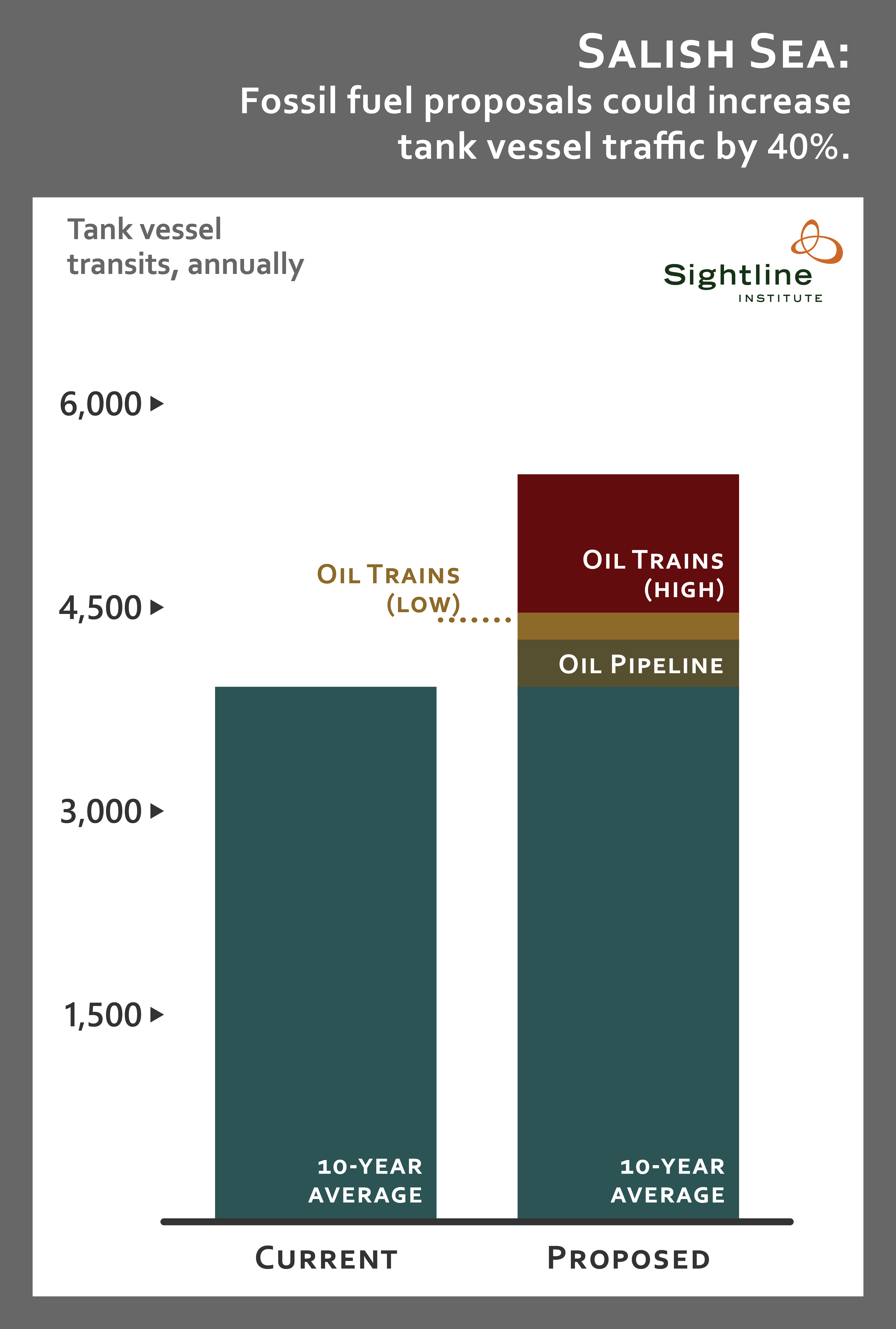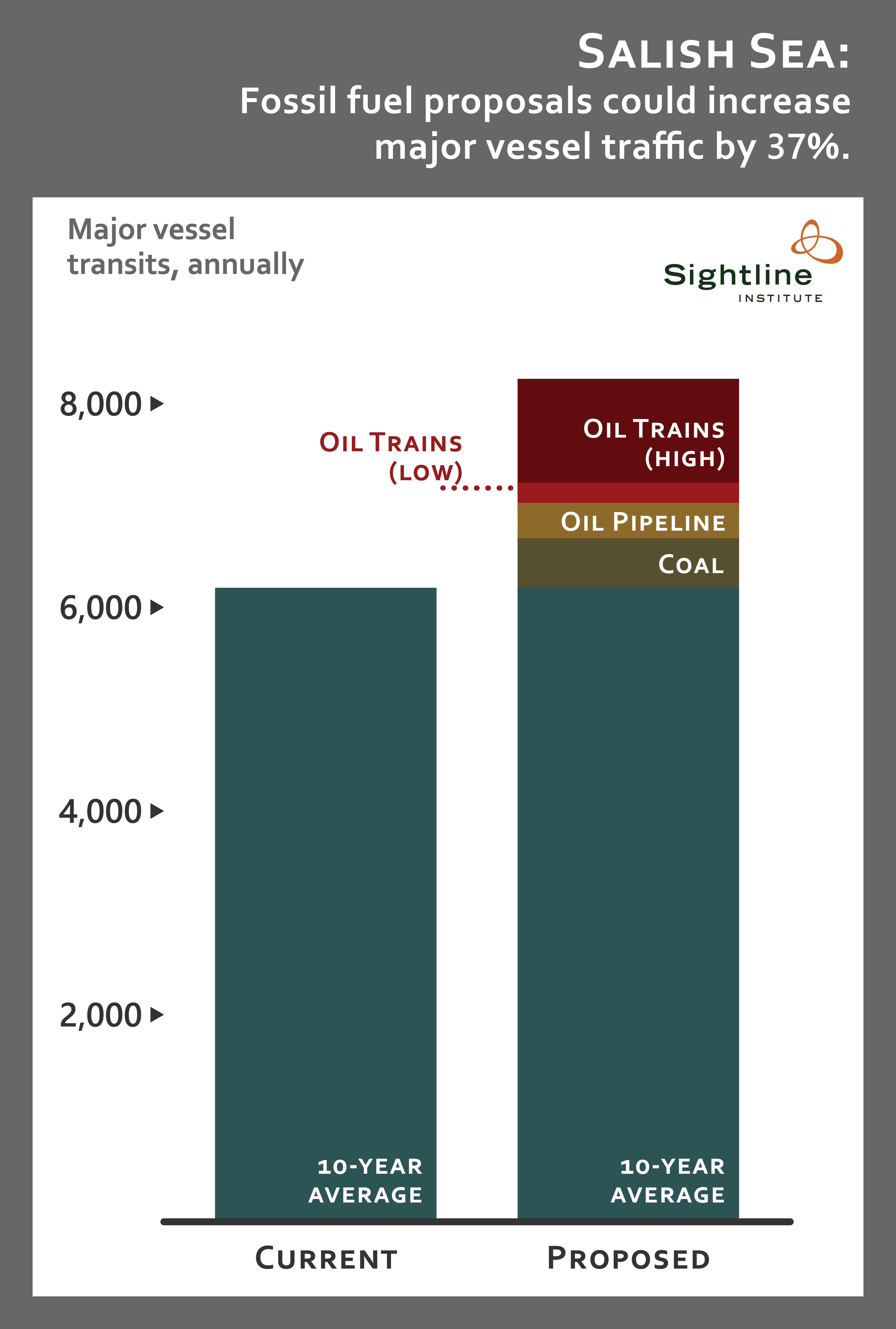The Northwest’s most important waters are under a near-constant threat of oil spills. It’s a fact made plain by the historical record of major spills and the dozens of recent close calls, as well as the best available data and modeling analysis of oil spills risks.
Yet the risk of spills could soon increase, perhaps dramatically. A spate of new fossil fuel shipment proposals could well generate very large increases in both oil transport and overall vessel traffic in places like the Salish Sea. To provide a clearer picture of what’s ahead, we crunched the numbers. Using the Washington Department of Ecology’s “Vessel Transit and Entry Counts” database, we calculate the average volume of ship and barge traffic over the last decade in contrast that to the number of vessel trips that would be induced by newly-built and planned fossil fuel sites in the region.
The result? We find that new crude oil facilities could create a 40 percent increase in the number of tank vessels—tanker ships and tank barges—crossing the Salish Sea.

Our accounting includes the proposed Trans Mountain Pipeline expansion that would deliver an additional 590,000 barrels of oil per day to a terminal near Vancouver, British Columbia. We also counted oil train deliveries to each of the five refineries on the shores of Puget Sound because there is every reason to believe that these facilities may act as port terminals, simply transferring crude oil from trains directly to out-bound vessels without ever refining it. (For a fuller exposition of this dynamic, see the “notes and methods” section, below.)
More loaded oil tankers increases spill risks in an obvious way. Less obvious yet still serious is the risk posed by a growing number of large vessels of any stripe moving around the labyrinthine channels and reefs of the Salish Sea. Of particular importance is another fossil fuel export proposal, the Gateway Pacific coal terminal planned for Whatcom County, Washington, which would generate 487 new vessel transits through the Salish Sea each year.
Compared to the entire fleet of large vessels in the Salish Sea, fossil fuel shipments—coal and oil combined—could increase overall major vessel traffic by up to 37 percent.

Our estimates are very likely too conservative because we do not count ancillary vessel trips induced by these fossil fuel projects, such as the refueling (“bunkering“) vessels that would be required to serve ocean-going cargo ships, nor the possibility of re-loading (“lightering“) activities.
For a more complete accounting of fossil fuel vessel traffic serving these coal and oil sites, see the graphic below.

Notes and methods. The data we report here come from the Washington Department of Ecology’s “Vessel Transit and Entry Counts” database that we parsed into three regions: Puget Sound, the Columbia River, and Grays Harbor. Our figures refer to “transits,” which are ship movements, rather than “vessels,” which refer to unique ships. A vessel may make multiple transits in a given year, so estimating vessel traffic is best done using transit numbers. There are, however, some methodological wrinkles in the VEAT data, such as an apparent discrepancy in the way that barges and ships are counted. Barge transits are defined as “any significant move between two locations, via Washington State waters, while transporting oil or chemicals,” while ship transits are defined as “the passage of a vessel from sea or from Canadian waters into Washington waters…the trip back to sea is not counted.” In other words, a movement by a barge (between, say, two ports within Puget Sound) would be counted as a barge transit, while a similar movement by a ship would not be counted as a ship transit. Our estimates of future vessel traffic strive for consistency with VEAT’s method of tracking barge and ship movements.
Data for the Gateway Pacific coal terminal in Washington come from the official project documents here.
Data for the Fraser Surrey Docks coal terminal in British Columbia come from official project documents here and assume that the proponents are successful in amending their permit to service the facility only with ocean going vessels rather than a larger number of barges. We estimate vessel traffic for the site at its full capacity, 8 million tons annually, rather than the initial capacity of 4 million tons per year.
Data for the Westshore Terminals expansion come from official permit documents here.
Data for the Neptune Terminals expansion come from official project documents here.
Data for the Trans Mountain Pipeline expansion in British Columbia come from the official project documents here. (We count only additional vessels that would serve the pipeline’s port terminus owing to the expansion capacity.)
For the five Puget Sound refineries, each of which is operating or planing to operate a crude oil-by-rail terminal, we used data in Sightline’s report, “The Northwest’s Pipeline on Rails,” as well as in the Washington Department of Ecology’s report, “2014 Marine and Rail Oil Transportation Study.” Our estimates assume that oil arriving by train is additional to the oil already transported to the refinery. Although industry officials claim that oil delivered by train will offset existing supplies of crude and thereby possibly reduce vessel traffic, we see no reason to believe this is the case now or will be true in the future. These refineries can (and may already be) acting as port terminals, offloading crude oil from trains and placing it directly on vessels for shipment to domestic or foreign markets. Note that Canadian oil is not subject to the “ban” on US crude exports, and that the oil industry is actively working to erode and eliminate the existing restrictions on shipping US crude abroad.
We made two estimates for oil from trains: the high estimate assumes that all oil is transported by tank barges carrying 150,000 barrels each, while the low estimate assumes that all oil is transported by Panamax tankers carrying roughly 460,570 barrels each. Tank barge capacities can vary widely, from as small as 10,000 to as large as 327,000 barrels; we chose 150,000 because it is the size that will be used at new oil terminals planned for Grays Harbor, and it seems to be slightly larger than typical tank barge average capacity. Our tanker capacity estimate of 460,570 reflects the actual historical record from 2001 to 2010 of vessels calling on BP’s Cherry Point refinery dock.


Comments are closed.